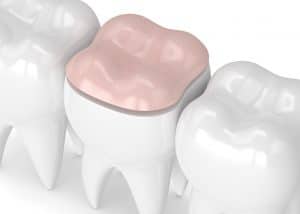 Traditional dental crowns have been around for centuries, and their basic design hasn’t changed much. For example, dental crowns have always been designed to replicate and restore the visible crown portion of your tooth, which is also called its crown, making it an excellent option for addressing a wide range of tooth concerns. Today’s dental crowns, however, are able to accomplish these goals with a heightened level of realism, more successful long-term results, and with materials that allow them to blend in seamlessly with your smile’s appearance.
Traditional dental crowns have been around for centuries, and their basic design hasn’t changed much. For example, dental crowns have always been designed to replicate and restore the visible crown portion of your tooth, which is also called its crown, making it an excellent option for addressing a wide range of tooth concerns. Today’s dental crowns, however, are able to accomplish these goals with a heightened level of realism, more successful long-term results, and with materials that allow them to blend in seamlessly with your smile’s appearance.
When your tooth’s crown fractures
There many types of tooth cracks that can be successfully corrected without having to completely cap your tooth’s crown. For example, minor or mild cracks in a tooth’s surface can sometimes be repaired with cosmetic tooth bonding, or with a custom-designed porcelain veneer, which don’t require much preparation of your natural tooth structure. However, if your tooth suffers a more significant fracture in its structure, then the most appropriate way to treat it and prevent the fracture from getting worse could be to place a dental crown over it.
When a piece breaks off your tooth
Having your tooth fracture significantly is one thing. The discomfort can make biting and chewing difficult, and the fracture can get worse over time. The same is true when a piece breaks off of your tooth’s structure, even if the broken piece seems small and insignificant. A broken tooth is not only damaged, but also structurally weaker and, in many cases, no longer shaped properly to preserve your bite’s balance. Designing a dental crown to mimic the tooth’s healthy size and shape, then placing the crown over the broken tooth, can help restore the tooth’s structural integrity and stop the tooth from suffering more extensive damage.
When you lose a single tooth
Tooth loss isn’t something that dental crowns have always been able to address on their own. Typically, a dental crown can be utilized to support a dental bridge to replace a lost tooth. Today, however, modern dental crowns can be combined with dental implant posts, which are root-like prosthetic posts, to create a more lifelike replacement for a lost tooth. The lifelike dental crown can closely replicate the size, shape, and appearance of your lost tooth’s crown, while the dental implant replaces the lost tooth’s root and serves as a foundation to support the replacement dental crown.
Learn if a dental crown can save your smile
The most appropriate treatment for any dental concern is the one that addresses your problem and helps you preserve your long-term oral health. To learn more, schedule an appointment by calling Allen & Neumann Family Dentistry in Pella, IA, today at (641) 628-1121.



